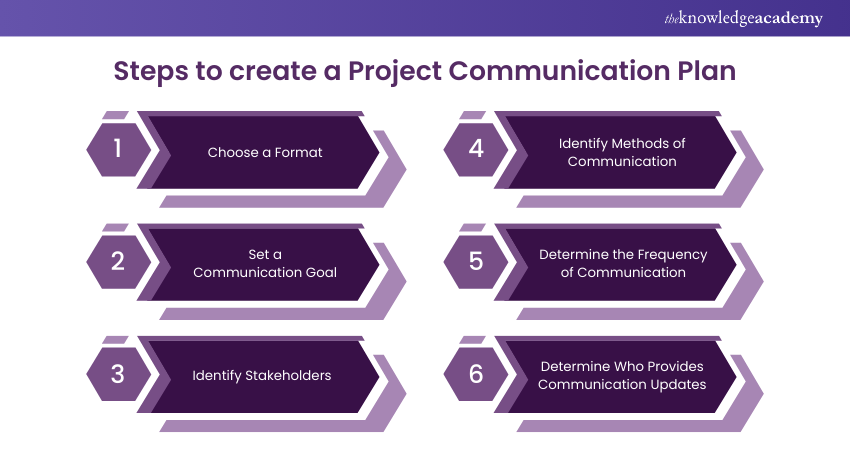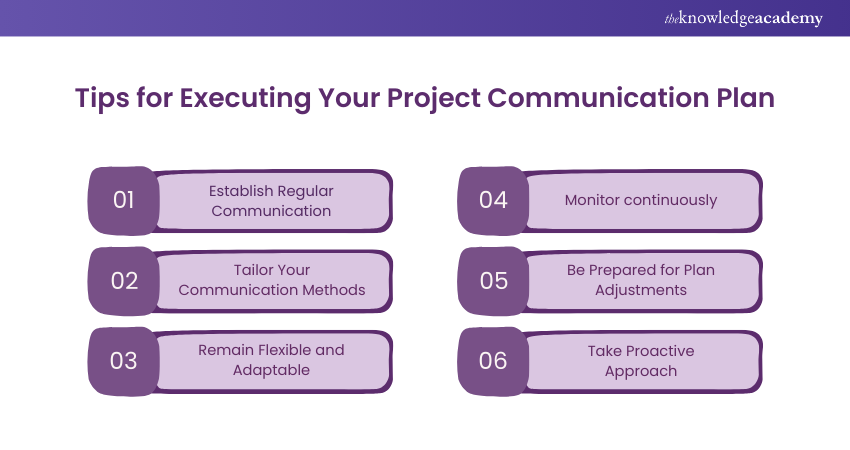We may not have the course you’re looking for. If you enquire or give us a call on +0800 780004 and speak to our training experts, we may still be able to help with your training requirements.
We ensure quality, budget-alignment, and timely delivery by our expert instructors.

In the realm of Project Management, success goes beyond just ticking off tasks and hitting deadlines—it's about effective communication. Meet the Project Communication Plan, the unsung hero of seamless Project Execution. Surprisingly, many project managers overlook this critical tool.
Dive into this blog to discover how to excel in project collaboration and coordination. Uncover vital tips for mastering the Project Communication Plan and see how it ensures smooth project delivery. Read on to explore its key benefits, best practices, and how this plan can transform your project management approach.
Table of Contents
1) Understanding What is a Project Communication Plan
2) Why is a Project Management Communication Plan Important?
3) Steps to Create a Project Communication Plan
4) Communication Plan Examples
5) What to Do if the Project Plan Changes
6) Tips for Executing Your Project Communication Plan
7) Conclusion
Understanding What is a Project Communication Plan
A Project Communication Plan is a written document that displays how important information will be shared with stakeholders throughout the project. It also specifies when, how, and who will receive the communication, as well as how frequently those recipients can expect it.
For example, if you are managing a new website’s launch, you must know how to divide the work into several activities, including wireframing, copywriting, and coding. In addition, you must decide what you will communicate to your stakeholders at each project stage.
Why is a Project Communication Plan Important?
The Project Communication Plan carries a vast significance in the modern corporate ecosystem. It allows organisations to create effective and efficient business strategies to optimise the ongoing project workflows. Below, we have illustrated its importance in pointersx:
a) Ensures clear, consistent, and timely communication among all project stakeholders.
b) Prevents miscommunication, which can lead to missed deadlines, misunderstandings, and project failure.
c) Outlines who need to be informed, what information they require, and when it should be delivered.
d) Maintains alignment and ensures all team members, clients, and stakeholders are on the same page.
e) Fosters accountability and transparency by clearly defining roles, responsibilities, and communication channels.
f) Improves collaboration and speeds up decision-making and problem-solving.
g) Mitigates risks by allowing quick communication of changes or unforeseen challenges.
h) Ensures the team can adapt swiftly, minimising the impact of disruptions and keeping the project on track.
i) Promotes project success by driving smoother project execution and better outcomes for all involved.
When a project plan or Project Charter changes, adapting quickly and communicating effectively
Steps to Create a Project Communication Plan
Creating a Project Communication Plan involves highly structured strategies and careful planning. Here is a list highlighting the various steps you can follow to create a Project Communication Plan:

1) Choose a Format
As an initial step, you must choose a platform that can easily provide you with feedback on your Communication Plan. In today's time, many Project Managers create their Communication Plan using a Word document or a spreadsheet. However, you ought to opt for a visual solution, like a timeline or a flowchart, that clearly conveys the frequency of Communication.
2) Set a Communication Goal
Whatever you hope to accomplish, you must create a successful Communication Plan. Your goal is to keep stakeholders informed about the project's progress so that they can continue to advocate for it.
3) Identify Stakeholders
Numerous stakeholders collaboratively work on a Project. That is why you must know the stakeholders with whom you’ll be communicating throughout the Project and prepare a list. To do so, you must prioritise each stakeholder based on their level of influence and interest. This can help you determine the level of Communication required.
4) Identify Methods of Communication
Your Communication Plan is instrumental in ensuring that pertinent information reaches the appropriate stakeholders. It should also specify the communication methods.
The selected method may vary depending on the kind of data being shared. Possible Communication methods include weekly check-ins, meetings (in-person or virtual), status reports, formal presentations, surveys, Project dashboards, etc. Selecting the appropriate method is essential for the effective dissemination of information.
5) Determine the Frequency of Communication
You should specify the frequency of each kind of communication and how often you'll engage with stakeholders. You must also ensure that this information is included in your Project Management Communication Plan. Scheduling these Communication intervals in your calendar can ensure timely and consistent engagement.
6) Determine Who Provides Communication Updates
In many instances, the responsibility for managing Communication within a Project lies with the Project Manager. However, if this position is not explicitly delegated to the Project Manager, it is necessary to designate a specific individual to provide updates. This ensures that there's clarity and accountability regarding Communication channels and information dissemination.
Give your Projects a better structure by signing up for our Introduction to Project Management Certification Course now!
Communication Plan Examples
Every communication plan is customised to meet the unique requirements of your project, team, and customer. You can use the examples below as a reference for creating your communication strategy.
a) Project Update Protocol: This refers to the method and frequency of updating stakeholders, team members, and clients about a project's progress, challenges, and milestones. For instance, establishing a weekly email update with critical highlights and upcoming tasks can be part of the Project update protocol.
b) Customer Complaint Resolution: This outlines the steps and channels through which customer complaints are received, acknowledged, investigated, and resolved. For example, a customer service Communication Plan may include a dedicated email address or hotline for complaints, along with a timeline for resolution and follow-up.
c) Order Fulfilment: This involves the crucial communication strategy for managing orders from placement to delivery, including notifications, tracking, and addressing any issues that arise. An example would be an automated email confirmation upon order placement, followed by updates at key stages of fulfilment and a feedback mechanism upon delivery.
d) Web Copy Creation: This pertains to the process of developing and refining content for a website, including Communication between content creators, editors, and stakeholders. For instance, a Communication Plan for web copy creation might include regular meetings or check-ins to discuss content requirements, deadlines, and revisions.
What to Do if the Project Plan Changes?
When a project plan changes, adapting quickly and communicating effectively is crucial to ensure the project stays on track. A well-structured approach can help prevent confusion and keep everyone aligned. Here are the key steps to follow when handling changes to the project plan:
1) Update the Project Communication Plan to reflect the new direction.
2) Identify which stakeholders need to be informed about the changes.
3) Determine what specific information needs to be conveyed.
4) Choose the best channels to communicate the updates.
5) Ensure everyone involved understands the implications of the change to maintain alignment and prevent confusion or delays.
6) Set up meetings or check-ins to clarify any doubts and ensure that everybody is in agreement.
7) Adjust the project timeline, resources, and deliverables based on the new scope.
8) Share regular updates and progress reports with stakeholders to keep them informed about the project's evolution.
9) Manage expectations and handle further adjustments proactively to minimise disruptions to the overall project goals.
Tips for Executing Your Project Communication Plan
Executing your Project Communication Plan effectively requires attention to detail and adaptability. Here are some vital tips to ensure seamless communication throughout your project:

1) Establish Regular Communication: Whether through daily check-ins, weekly reports, or monthly status meetings, regular communication ensures that everyone stays informed and can address any issues quickly.
2) Tailor Your Communication Methods: Some stakeholders may prefer concise email updates, while others might need detailed reports or in-person meetings to grasp the project's progress.
3) Remain Flexible and Adaptable: Projects often experience changes, and your communication plan should evolve accordingly.
4) Continuous monitoring: Monitor the effectiveness of your communication channels and gather feedback from team members and stakeholders.
5) Be Prepared for Plan Adjustments: If certain communication methods aren’t working as intended, it’s crucial to make adjustments to your existing plans to improve clarity and engagement.
6) Take a Proactive Approach: Ensure that your project runs smoothly and that all involved parties are aligned on goals and expectations.
Collaborate efficiently with stakeholders by signing up for our Project And Infrastructure Financing Training now!
Conclusion
We hope you understand a Project Communication Plan and how it outlines the most important information for the project's stakeholders and team members. The Plan primarily assists the project manager in determining the recipients and frequency of communication. Through its vast applications and well-written structure, Project Managers ensure their projects stay on track throughout the execution lifecycle.
Deliver Projects effectively by signing up for our Project Management Course now!
Frequently Asked Questions
What Are the Core Components of a Communications Plan?

The core components of Project Communication Plan include Plan purpose, situational analysis, audience personas, messaging, channels, Communications matrix, goals, strategies, tactics, calendar, and budget.
What Is a Communication Plan Framework?

A communication framework is essential in project management, helping to plan, execute, and evaluate communication activities. However, it’s not just about communication throughout the lifecycle but ensuring that all stakeholders are informed, engaged, and aligned with the project’s goals.
What are the Other Resources and Offers Provided by The Knowledge Academy?

The Knowledge Academy takes global learning to new heights, offering over 3,000 online courses across 490+ locations in 190+ countries. This expansive reach ensures accessibility and convenience for learners worldwide.
Alongside our diverse Online Course Catalogue, encompassing 19 major categories, we go the extra mile by providing a plethora of free educational Online Resources like News updates, Blogs, videos, webinars, and interview questions. Tailoring learning experiences further, professionals can maximise value with customisable Course Bundles of TKA.
What is The Knowledge Pass, and How Does it Work?

The Knowledge Academy’s Knowledge Pass, a prepaid voucher, adds another layer of flexibility, allowing course bookings over a 12-month period. Join us on a journey where education knows no bounds.
What are the Related Courses and Blogs Provided by The Knowledge Academy?

The Knowledge Academy offers various Project Management Courses, including the Project Management Office Fundamentals Course, Programme Management (PgM) Fundamentals Training, and Jira Training. These courses cater to different skill levels, providing comprehensive insights into the Project Planner Job Description.
Our Project Management Blogs cover a range of topics related to Project Communication, offering valuable resources, best practices, and industry insights. Whether you are a beginner or looking to advance your Power BI skills, The Knowledge Academy's diverse courses and informative blogs have got you covered.
Upcoming Project Management Resources Batches & Dates
Date
 Introduction to Project Management Course
Introduction to Project Management Course
Fri 14th Mar 2025
Fri 9th May 2025
Fri 15th Aug 2025
Fri 10th Oct 2025
Fri 12th Dec 2025






 Top Rated Course
Top Rated Course



 If you wish to make any changes to your course, please
If you wish to make any changes to your course, please


